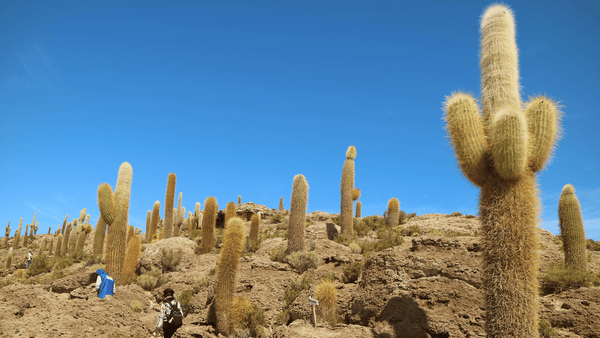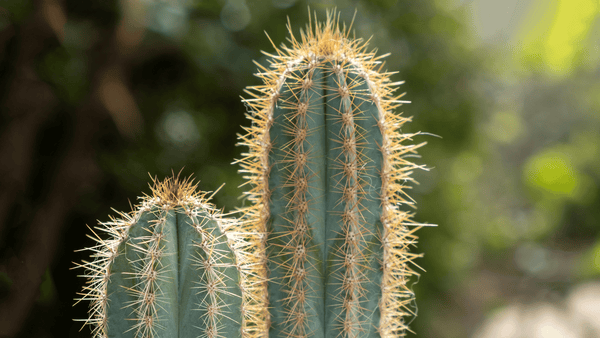
San Pedro and Trichocereus Cactus Care
Tips for growing San Pedro and other Trichocereus cacti indoors.
Trichocereus Cacti Make Great House Plants!
Where do San Pedro Cactus originate from?
The San Pedro and the trichocereus cacti are arguably the most popular columnar cacti among desert gardening connoisseurs. They are famously known for their traditional medicinal properties emanating from their mescaline content but are now widely grown as an ornamental cactus. San Pedro have been used for healing and religious divination in the Andes Mountains region for over 3,000 years. These columnar cacti first naturally occurred on the Western slopes of the Andes in Ecuador and Northern Peru at 1500-3000 meters in the Andes. Today, San Pedro is scientifically known as Trichocereus pachanoi or sometimes Echinopsis pachanoi. Close relatives are the Peruvian Torch (Trichocereus peruvianus,) and Bolivian Torch (Trichocereus bridgesii). They too contain mescaline and are sometimes referred to as San Pedro.

Trichocereus can grow up to 20 feet tall in their natural habitats but can easily grow to a smaller scale indoors. San Pedro cactus makes a great house plant because it is relatively easy to care for, hardy, and can thrive in a wide range of indoor conditions. San Pedro cactus also has a unique appearance, with its thick green stem and spines, making it a beautiful addition to any indoor garden.
How are San Pedro Cactus Used?
Cultivation of San Pedro for consumption is illegal and possession of mescaline and related compounds is illegal in most countries. However, it is readily available and perfectly legal to grow San Pedro for ornamental purposes in Canada. But be sure to keep it out of reach of children and pets, as it is obviously poisonous if ingested. San Pedro contains alkaloids which, if ingested, can produce mescaline-like hallucinogenic effects.
San Pedro are otherwise beautiful, characteristic cacti. They’ll bloom enormous, incredible white flowers! The flowers first appear from the areola as small hairy balls that extend up to nine inches (23 cm) long, then burst open, with a beautiful aroma that fills your air at night.
San Pedro ranges in color from light green to deep emerald, sometimes with a glaucous powdery coating that can be rubbed off. This column cactus has six to eight vertical ribs that are rounded in shape. The ribs give the cactus a star-like shape from above. A defining feature are the areoles that sit within transverse depressions spaced at regular intervals. Each areola looks like a small tuft of hair from which emerges three to seven dark yellow or brown spines that can grow to three-quarters of an inch long in the wild, although they are much shorter on cultivated, indoor cacti.
Trichocereus cacti are generally easy to care for if you can give them the basics. You can plant them and forget about them, but there are a few key things that need to be set up properly. When growing San Pedro at home, there are three things to consider: proper soil, the right amount of water, and sufficient light. For San Pedro, the main growing season is in summer. In Equatorial Peru, they have hot summers with regular rain. In the winter, the cacti go into a hibernation phase and stop growing.
How to Care for Your Trichocereus Indoor Cactus

Soil for your San Pedro cactus
San Pedro cactus need well-draining soil to thrive. A cactus potting soil or a soil mix made for cactus work well, or you can make your own soil by mixing equal parts of potting soil, coarse sand, and perlite. Containers should be wide and shallow, as the plant needs plenty of room to grow. Due to their fast growth rate err on the side of larger to give the plant enough room to grow. You should also ensure that your chosen container has good drainage. You can help with this by adding an inch of pebbles to the bottom of your container or use a pot with drainage holes.
Sunlight for your San Pedro Cactus
In general, Trichocereus pachanoi grows well in full sun or light shade during hot summers. Give it at least 6 hours of bright sun a day. But after winter, be sure to gradually introduce the plant indoors to direct light, as it may get sunburned if transferred directly to bright sun. Indoors, this multi-stemmed columnar cactus will benefit from additional lighting from grow lights. Lights can either be sodium halide, which are used in many indoor setups, or full-spectrum LED lights. They generally need lots of light and can start etiolating as they stretch towards the nearest source if light conditions are insufficient.
Watering Your Trichocereus
Watering your San Pedro cactus is important to ensure its survival, but it's also crucial to not over-water. San Pedro are drought-tolerant and like to be dry. Water it only when the soil is completely dry. Allow the water to drain completely and don’t water again until the soil is dry. In the summer, this could be every one or two weeks. But from October to April, you can get by with watering as little as once per three or four weeks. Although San Pedro can be forgiving, overwatering is one of the main reasons that Trichocereus die, so when in doubt, don’t water it.
Fertilizing is another important aspect of growing a healthy San Pedro cactus. Use a well-balanced water-soluble fertilizer and apply it every two or three weeks during the spring and summer months. Reduce fertilization to once a month in the fall and winter. Be sure to follow the package directions for application rates.
Temperature and Humidity
The ideal temperature range for growing a San Pedro cactus is between 18 and 27 degrees Celsius. San Pedro are tolerant of lower temperatures, so a little exposure on the low end of this range won’t hurt it.
The ideal humidity range for San Pedro Cactus plants is between 40% to 60%. If the humidity level drops below 40%, the plant may start to show signs of stress, such as wilting, yellowing, and dropping of leaves. Conversely, if the humidity level exceeds 60%, it can lead to fungal growth, root rot, and other diseases that can harm the plant.
Possible Pest or Diseases
The San Pedro cactus is a hardy and resilient plant that can withstand a variety of pests and diseases. However, it is not completely immune to infestations and infections, and it is important to be aware of the common pests and diseases that can affect the San Pedro cactus. Here are some tips on how to treat them.
Spider mites will sometimes bother a Trichocereus. These are tiny pests that can cause yellowing and wilting of the cactus. To get rid of spider mites, you can try spraying the affected plant with a mixture of water and neem oil or insecticidal soap. It is important to repeat this treatment every few days until the mites are completely gone.
Mealybugs are white, cottony pests that can cause stunted growth and yellowing of the cactus. These bugs are usually found in the crevices of the plant and can be difficult to remove. To treat mealybugs, you can use a cotton swab dipped in rubbing alcohol to wipe them off the plant. Alternatively, you can try spraying the plant with a mixture of water and neem oil or insecticidal soap.
Scales are small insects that resemble small cottony tufts or dome-shaped shells. They can hide quite easily. They love cacti and can hide easily between the ribs. Scales are easily scrubbed off when caught early. You can scrape them off with your fingernail or use a little warm water and biodegradable detergent, brushing them off with a toothbrush. Keep in mind that knocking them off means they can climb back up the cactus.
You will often see black spots on a San Pedro cactus. If a black spot is soft, it may be due to rot. In this case, it should be removed by cutting it until there is healthy tissue visible. In such a case, it’s a good idea to check the roots for rot as well.
However, if the black spots are hard, this is likely just scarring due to secreting alkaloids that lie just underneath the skin. Alkaloids (usually in columnar cacti) are substances just under the skin of the plant and if the skin occurs any kind of damage or similar stress, the alkaloids can leak out and turn black which is nothing to worry about.
There are several things that can cause this: contact with thorns from neighboring cacti, overwatering and sometimes from a reaction to some chemical sprays such as insecticide or fungicide. This phenomenon is called edema. Formally spelled “oedema,” edema is a condition that can affect all plants, including San Pedro and other succulents. The condition isn’t caused by any type of bug or infection. Instead, edema is a symptom of abnormal water retention. Edema is most often characterized by small, papule-like hard, black spots on the skin of the cactus that are raised. These welts form in small clusters when a succulent takes in too much water. The excess water causes cells in the skin to rupture and release alkaloids. These spots won’t spread and aren’t harmful to the plant. Their impact is purely aesthetic. However, it may be a sign that the cactus is getting too much water or humidity. For home-grown San Pedro, this phenomenon is very common and nearly impossible to avoid.
This video explains the various black spots that can appear on these cacti:
Propagation Methods for San Pedro and Trichocereus Cacti
Expanding your collection of San Pedro and Trichocereus cacti can be a rewarding endeavor, and understanding propagation techniques is essential for successful growing. Below we'll briefly look at different methods for propagating these distinctive cacti.
Propagation by Seeds
Propagation by seed is a fundamental approach to cultivating new San Pedro and Trichocereus cacti. Start by obtaining mature seeds from ripe fruits or a reputable supplier. Then, create an optimal germination environment by using a well-draining soil mix and planting seeds at a shallow depth. Maintain consistent moisture levels in the soil without saturating it, while ensuring the provision of heat and indirect light to facilitate germination. Patience is essential as the seeds germinate, eventually producing seedlings ready for transplanting.
Propagation by cuttings
Cuttings stand out as a popular method for effectively propagating San Pedro and Trichocereus cacti. Select sturdy, mature stems and cut them carefully with a clean, sharp knife, ensuring that each cutting has at least one areole. Allow the cuttings to undergo a healing process for a few days to prevent any risk of rot, before planting them in well-draining soil. Maintain a slightly moist soil environment and provide abundant indirect light to encourage root development. Over time, the cuttings will root and establish themselves as independent plants.
Rejects (pups)
San Pedro and Trichocereus cacti often produce suckers or "pups" alongside mature plants, providing a simple means of propagation. Separate these suckers from the parent plant using a clean, sharp knife, and allow the cut ends to dry and scar before planting in well-draining soil. Ensure proper care, including adequate exposure to sunlight and sufficient watering, to facilitate healthy root growth and plant establishment.
Grafting
Grafting can be considered as an advanced propagation technique for San Pedro and Trichocereus cacti that is especially useful for enhancing specific traits or amalgamating different varieties. Start by selecting a sturdy rootstock and carefully shape it to create a flat surface. Next, identify a suitable scion – a young, actively growing shoot – of the desired San Pedro or Trichocereus variety. Secure the scion securely to the rootstock plant using grafting tape or similar materials. With meticulous care and attention, the graft union will heal, and the scion will thrive, resulting in a grafted plant with combined characteristics.
Conclusion
The San Pedro cactus is a unique and hardy indoor cactus that is relatively easy to care for. It is important to make sure that the cactus gets enough sunlight, is planted in well-draining soil, and is watered appropriately to ensure its survival. Black spots can appear on your San Pedro in humid or overly moist conditions. These black spots don’t do any damage and can be ignored. In time they will callous and turn white. With proper care, the San Pedro cactus can be enjoyed for years to come and makes a great gift for plant lovers.
Cactus en Ligne Team
www.cactusenligne.ca ∙ bonjour@cactusenligne.ca